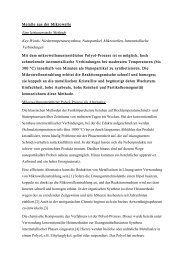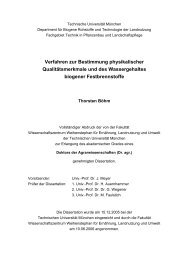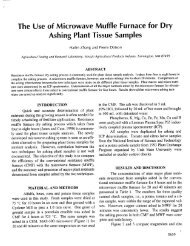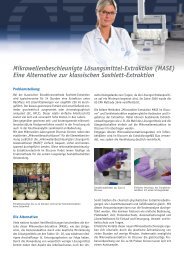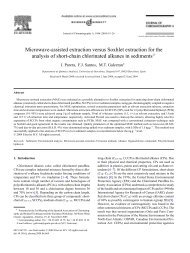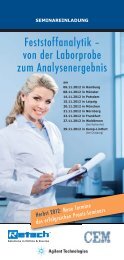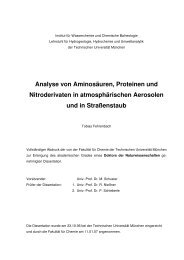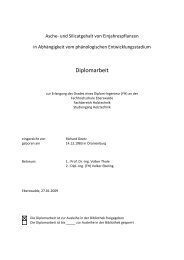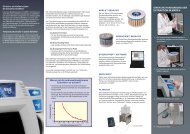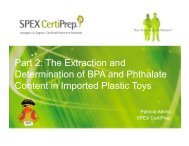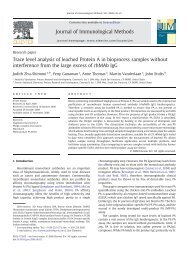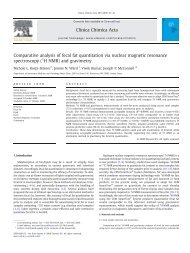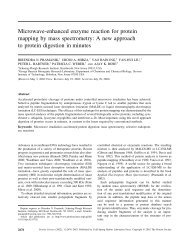Rapid Microwave Synthesis and Purification of Porous Covalent ...
Rapid Microwave Synthesis and Purification of Porous Covalent ...
Rapid Microwave Synthesis and Purification of Porous Covalent ...
Create successful ePaper yourself
Turn your PDF publications into a flip-book with our unique Google optimized e-Paper software.
Communication<br />
More About This Article<br />
Subscriber access provided by The University <strong>of</strong> Liverpool<br />
<strong>Rapid</strong> <strong>Microwave</strong> <strong>Synthesis</strong> <strong>and</strong> <strong>Purification</strong><br />
<strong>of</strong> <strong>Porous</strong> <strong>Covalent</strong> Organic Frameworks<br />
Neil L. Campbell, Rob Clowes, Lyndsey K. Ritchie, <strong>and</strong> Andrew I. Cooper<br />
Chem. Mater., Article ASAP • DOI: 10.1021/cm802981m<br />
Downloaded from http://pubs.acs.org on January 5, 2009<br />
Additional resources <strong>and</strong> features associated with this article are available within the HTML version:<br />
• Supporting Information<br />
• Access to high resolution figures<br />
• Links to articles <strong>and</strong> content related to this article<br />
• Copyright permission to reproduce figures <strong>and</strong>/or text from this article<br />
Chemistry <strong>of</strong> Materials is published by the American Chemical Society. 1155<br />
Sixteenth Street N.W., Washington, DC 20036
<strong>Rapid</strong> <strong>Microwave</strong> <strong>Synthesis</strong> <strong>and</strong> <strong>Purification</strong> <strong>of</strong><br />
<strong>Porous</strong> <strong>Covalent</strong> Organic Frameworks<br />
Neil L. Campbell, Rob Clowes, Lyndsey K. Ritchie, <strong>and</strong><br />
Andrew I. Cooper*<br />
Department <strong>of</strong> Chemistry <strong>and</strong> Centre for Materials<br />
DiscoVery, UniVersity <strong>of</strong> LiVerpool, Crown Street, LiVerpool<br />
L69 7ZD, United Kingdom<br />
ReceiVed NoVember 2, 2008<br />
ReVised Manuscript ReceiVed December 11, 2008<br />
There has been a great deal <strong>of</strong> interest recently in<br />
microporous materials such as crystalline metal organic<br />
frameworks (MOFs) 1 <strong>and</strong> amorphous microporous organic<br />
polymers. 2 The first “covalent organic frameworks” 3 (COFs)<br />
were reported in 2005. COFs are crystalline porous aromatic<br />
framework materials linked by boroxine or boronate-ester<br />
groups. Since this initial report, 3 a number <strong>of</strong> other studies<br />
have described crystalline boroxine or boronate-ester COFs, 4,5<br />
with apparent Brunauer-Emmett-Teller (BET) surfaces<br />
areas (SBET) <strong>of</strong> up to 4210 m 2 g -1 in some cases (COF-103). 5<br />
This is interesting, for example, in terms <strong>of</strong> the potential <strong>of</strong><br />
these materials for gas physisorption. 6 The first COF (COF-<br />
1) 3 was synthesized by solvothermal self-condensation in<br />
sealed pyrex tubes <strong>of</strong> 1,4-benzenediboronic acid (BDBA).<br />
The product was reported to be a staggered P63/mmc<br />
hexagonal layered material linked by planar boroxine rings<br />
(SBET ) 711 m 2 g -1 ). COF-5 was mesoporous (SBET ) 1590<br />
m 2 g -1 ) <strong>and</strong> had an eclipsed boron nitride arrangement. 3<br />
Choice <strong>of</strong> solvent was important, as was control over reaction<br />
rates to ensure that the thermodynamic, ordered crystalline<br />
products are obtained. The use <strong>of</strong> a sealed reaction vessel<br />
ensured that H2O was available to maintain reversible<br />
* Corresponding author. E-mail: aicooper@liverpool.ac.uk.<br />
(1) Yaghi, O. M.; O‘Keeffe, M.; Ockwig, N. W.; Chae, H. K.; Eddaoudi,<br />
M.; Kim, J. Nature 2003, 423, 705-714.<br />
(2) (a) Jiang, J. X.; Su, F.; Trewin, A.; Wood, C. D.; Campbell, N. L.;<br />
Niu, H.; Dickinson, C.; Ganin, A. Y.; Rosseinsky, M. J.; Khimyak,<br />
Y. Z.; Cooper, A. I. Angew. Chem., Int. Ed. 2007, 46, 8574–8578. (b)<br />
Kuhn, P.; Antonietti, M.; Thomas, A. Angew. Chem., Int. Ed. 2008,<br />
47, 3450–3453. (c) Jiang, J-X.; Su, F.; Trewin, A.; Wood, C. D.; Niu,<br />
H.; Jones, J. T. A.; Khimyak, Y. Z.; Cooper, A. I. J. Am. Chem. Soc.<br />
2008, 130, 7710. (d) Makhseed, S.; Samuel, J. Chem. Commun. 2008,<br />
4342–4344, DOI: 10.1039/b805656k. (e) Budd, P. M.; Ghanem, B. S.;<br />
Makhseed, S.; McKeown, N. B.; Msayib, K. J.; Tattershall, C. E.<br />
Chem. Commun. 2004, 230. (f) McKeown, N. B.; Gahnem, B.; Msayib,<br />
K. J.; Budd, P. M.; Tattershall, C. E.; Mahmood, K.; Tan, S.; Book,<br />
D.; Langmi, H. W.; Walton, A. Angew. Chem. 2006, 118, 1836;Angew.<br />
Chem. Int. Ed. 2006, 45, 1804.<br />
(3) Côté, A. P.; Benin, A. I.; Ockwig, N. W.; O’Keeffe, M.; Matzger,<br />
A. J.; Yaghi, O. M. Science 2005, 310, 1166–1170.<br />
(4) (a) Tilford, R. W.; Gemmill, W. R.; zur Loye, H. C.; Lavigne, J. J.<br />
Chem. Mater. 2006, 18, 5296–5301. (b) Côté, A. P.; El-Kaderi, H. M.;<br />
Furukawa, H.; Hunt, J. R.; Yaghi, O. M. J. Am. Chem. Soc. 2007,<br />
129, 12914–12915. (c) Hunt, J. R.; Doonan, C. J.; Le Vangie, J. D.;<br />
Côté, A. P.; Yaghi, O. M.; Mastalerz, M. Angew. Chem., Int. Ed. 2008,<br />
47, 445–447.<br />
(5) El-Kaderi, H. M.; Hunt, J. R.; Mendoza-Cortes, J. L.; Côté, A. P.;<br />
Taylor, R. E.; O’Keeffe, M.; Yaghi, O. M. Science 2007, 316, 268–<br />
272.<br />
(6) (a) Li, Y. W.; Yang, R. T. AIChE J. 2008, 54, 269–279. (b) Han,<br />
S. S.; Furukawa, H.; Yaghi, O. M.; Goddard, W. A., III J. Am. Chem.<br />
Soc. 2008, 130, 11580–11581.<br />
Chem. Mater. XXXX, xxx, 000–000<br />
Figure 1. Digital camera images recorded from the observation port <strong>of</strong> the<br />
microwave reactor showing COF-5 reaction <strong>and</strong> purification: (a) gray-purple<br />
COF-5 powder formed after initial synthesis; (b) removal <strong>of</strong> trapped HHTPoxidation<br />
impurities by microwave extraction process (acetone); (c) second<br />
microwave extraction results in purified gray COF-5 powder (SBET ) 2019<br />
m 2 g -1 ).<br />
conditions. These considerations (solubility, reaction rates,<br />
nucleation <strong>and</strong> growth, ability <strong>of</strong> structures to ‘self-heal’)<br />
are likely to be generally important for the synthesis <strong>of</strong> any<br />
ordered, crystalline porous polymers. Subsequent COFs were<br />
also synthesized solvothermally in sealed tubes (reaction<br />
times typically 72 h) under a variety <strong>of</strong> conditions. 4,5<br />
<strong>Microwave</strong> reactors are well-known for their impact on<br />
small molecule organic chemistry due to accelerated reaction<br />
times, cleaner products, <strong>and</strong> higher yields in many cases. 7<br />
Less-emphasized advantages <strong>of</strong> using microwave reactors<br />
are the potential for continual online monitoring, simultaneous<br />
control <strong>of</strong> reaction temperature <strong>and</strong> pressure, <strong>and</strong><br />
(recently) visual monitoring <strong>of</strong> the phase behavior in reactions.<br />
There are an increasing number <strong>of</strong> reports concerning<br />
the synthesis <strong>of</strong> organic polymers by microwave heating 8<br />
but much less attention has been given to microporous<br />
materials. Notably, Ni <strong>and</strong> Masel synthesized IRMOF<br />
materials using microwaves, 9 <strong>and</strong> recently, Bae et al. have<br />
used microwave heating to produce MOFs with very high<br />
CO2/CH4 gas separation selectivities. 10 We synthesized COF-<br />
5 3 under microwave heating conditions by preparing in a<br />
3:2 molar ratio solution <strong>of</strong> 1,4-benzenediboronic acid (BDBA;<br />
185 mg, 1.116 mmol) <strong>and</strong> 2,3,6,7,10,11-hexahydroxytriphenylene<br />
(HHTP; 241.5 mg, 0.745 mmol) in a 1:1 mixture<br />
<strong>of</strong> mesitylene: 1,4-dioxane (20 mL). This mixture was sealed<br />
under nitrogen in a 35 mL glass microwave tube <strong>and</strong> heated<br />
by microwave irradiation at 100 °C with stirring for 20 min<br />
at a power <strong>of</strong> 200 W using a CEM S-Class Explorer 96position<br />
microwave reactor with digital camera attachment.<br />
A gray precipitate was observed to form in the reaction vessel<br />
(Figure 1a). The supernatant solution became purple in color<br />
which we ascribe to the formation <strong>of</strong> an oxidized form <strong>of</strong><br />
HHTP. 3<br />
The resulting gray-purple powder was filtered under<br />
nitrogen <strong>and</strong> washed with acetone which had first been dried<br />
over 5 Å molecular sieves. To further purify the product <strong>and</strong><br />
(7) Kappe, C. O. Angew. Chem., Int. Ed. 2004, 43, 6250–6284.<br />
(8) (a) Wiesbrock, F.; Hoogenboom, R.; Schubert, U. S. Macromol. <strong>Rapid</strong><br />
Commun. 2004, 25, 1739–1764. (b) Germain, J.; Svec, F.; Fréchet,<br />
J. M. J. Chem. Mater. 2008, 20, 7069–7076. (c) Brown, S. L.; Rayner,<br />
C.; Graham, S.; Cooper, A. I.; Rannard, S.; Perrier, S Chem. Commun.<br />
2007, 21, 2145–2147.<br />
(9) Ni, Z.; Masel, R. I. J. Am. Chem. Soc. 2006, 128, 12394–12395.<br />
(10) Bae, Y. S.; Mulfort, K. L.; Frost, H.; Ryan, P.; Punnathanam, S.;<br />
Broadbelt, L. J.; Hupp, J. T.; Snurr, R. Q. Langmuir 2008, 24, 8592–<br />
8598.<br />
10.1021/cm802981m CCC: $40.75 © XXXX American Chemical Society<br />
A
B Chem. Mater., Vol. xxx, No. xx, XXXX Communications<br />
Figure 2. Powder diffraction pattern for COF-5 produced by microwave<br />
technique.<br />
to remove any starting materials or impurities trapped in the<br />
porous structure, the microwave reactor was employed for<br />
extraction purposes by heating the isolated COF-5 powder<br />
with 30 mL <strong>of</strong> dried acetone (55 °C, 20 min, 200 W). This<br />
extraction was repeated twice (images b <strong>and</strong> c in Figure 1)<br />
<strong>and</strong> this was found to remove all <strong>of</strong> the purple coloration<br />
(Figure 1c). The final purified COF-5 was isolated as a gray<br />
solid in 68% yield (235 mg) based on the starting materials.<br />
Powder X-ray diffraction (PXRD) data was obtained for<br />
the material from the loose powder mounted on a zero<br />
background holder, measured in reflection geometry (PANalytical<br />
MPD diffractometer). The diffraction pattern (Figure<br />
2) confirmed the crystallinity <strong>of</strong> the material <strong>and</strong> revealed<br />
no diffraction peaks which could be attributed to the starting<br />
materials. The diffraction pattern was comparable to that<br />
published previously. 3<br />
The sample was dried in a vacuum desiccator (24 h) <strong>and</strong><br />
then transferred to a st<strong>and</strong>ard gas sorption sample holder for<br />
outgassing at 90 °C under dynamic vacuum (1 × 10 -5 bar).<br />
High levels <strong>of</strong> porosity were confirmed by measuring the<br />
N2 gas adsorption/desorption isotherm for the desolvated<br />
material at 77.3 K (Figure 3a). The isotherm shape was<br />
reversible type IV <strong>and</strong> essentially identical to that reported<br />
previously, 3 including the characteristic “double step” in the<br />
relative pressure range P/Po ) 0-0.2.<br />
The BET model was applied to these data over the same<br />
relative pressure range reported previously 3 (P/Po ) 0.05-0.1),<br />
which resulted in an apparent BET surface area <strong>of</strong> 2019 m 2<br />
g -1 (correlation coefficient ) 0.998). 11 This is significantly<br />
higher than the reported SBET for COF-5 <strong>of</strong> 1590 m 2 g -1 . 3 In<br />
principle, this might be explained by different particle sizes.<br />
Indeed, SEM analysis (images b <strong>and</strong> c in Figure 3) suggested<br />
that the primary particulate size (
Communications<br />
does not, however, disprove the need for H2O to facilitate<br />
reversibility because the reflux condenser retains any condensate<br />
quite efficiently in the reaction flask.<br />
In addition to the synthesis <strong>of</strong> COF-5, microwave heating<br />
was utilized to synthesize COF-102, showing that this method<br />
is applicable to the synthesis <strong>of</strong> both 2D <strong>and</strong> 3D COFs. COF-<br />
102 was prepared by the self-condensation <strong>of</strong> tetraphenyl<br />
boronic methane (200 mg) in a 1:1 mixture <strong>of</strong> mesitylene:<br />
1,4-dioxane (20 mL). This mixture was sealed under nitrogen<br />
in a 35 mL glass microwave tube <strong>and</strong> heated by microwave<br />
irradiation at 100 °C with stirring for 20 min at a power <strong>of</strong><br />
200 W. The resulting white powder was filtered under<br />
nitrogen <strong>and</strong> washed with THF (anhydrous). The microwave<br />
reactor was again employed for extraction purposes by<br />
heating the isolated COF-102 powder with 30 mL <strong>of</strong> dried<br />
THF (65 °C, 20 min, 200 W). An apparent BET surface area,<br />
SBET, <strong>of</strong> 2926 m 2 g -1 (correlation coefficient ) 0.999) was<br />
obtained by N2 adsorption. This is broadly comparable to<br />
the SBET <strong>of</strong> 3472 m 2 /g reported for COF-102 prepared by<br />
conventional solvothermal methods as analyzed by Ar<br />
adsorption. 3 The PXRD <strong>and</strong> FTIR <strong>of</strong> COF-102 are comparable<br />
to those reported previously in the literature (see the<br />
Supporting Information). Interestingly, measurements suggested<br />
quite low hydrogen uptakes for COF-102, at least at<br />
low pressures (



